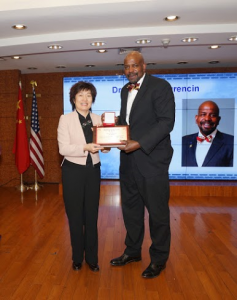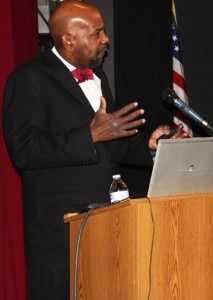By Cato T. Laurencin, M.D., Ph.D.
Last week, I had the honor and privilege of being the main keynote speaker at a regional meeting organized by the National Organization for the Professional Advancement of Black Chemists and Chemical Engineers (NOBCChE). The theme for the meeting is STEMulating Innovation from Discovery to Application. This regional meeting provided numerous opportunities to learn from peers and colleagues about their latest scientific findings in the STEM fields. My keynote lecture, “Regenerative Engineering: Theory and Practice” was held at the Louisiana State University. The object of my lecture is to highlight the increasing convergence between engineering, biology, and medicine. This meeting was packed with technical and professional development sessions, and industrial spotlights. Thank you to Dr. Marsha Cole, NOBCChE Southwest Regional Chair, for organizing such a nice meeting




 On April 3rd and 4th, the American Institute for Medical and Biological Engineering (AIMBE) hosted its annual 2-day meeting in Washington, DC. This event represents one of the premiere conferences where the leaders in medical and biological engineering from academia, industry, and government gather for cutting-edge programming, social events, and a chance to welcome the newest AIMBE fellows. This year, AIMBE highlighted the Distinguished Leadership Panel featuring the country’s leading experts in the field to discuss AIMBE’s next 25 years. I was honored to be on the panel with a number of distinguished leaders in the field, including Dr. Robert Nerem, Dr. Nicholas Peppas, and Dr. Kenneth Lutchen. I spoke about the organization’s need to be leaders in diversity, advocacy, and the promotion of next-generation science. The event was incredibly rewarding.
On April 3rd and 4th, the American Institute for Medical and Biological Engineering (AIMBE) hosted its annual 2-day meeting in Washington, DC. This event represents one of the premiere conferences where the leaders in medical and biological engineering from academia, industry, and government gather for cutting-edge programming, social events, and a chance to welcome the newest AIMBE fellows. This year, AIMBE highlighted the Distinguished Leadership Panel featuring the country’s leading experts in the field to discuss AIMBE’s next 25 years. I was honored to be on the panel with a number of distinguished leaders in the field, including Dr. Robert Nerem, Dr. Nicholas Peppas, and Dr. Kenneth Lutchen. I spoke about the organization’s need to be leaders in diversity, advocacy, and the promotion of next-generation science. The event was incredibly rewarding.




 As part of the Convergence: The Future of Health Workshop, I contributed some remarks to the “Challenges in Funding Convergence” panel held in Washington DC on March 25th. During this section, I discussed about my experiences finding funding for engineering research in the biomedical sciences. I shared some success stories from individuals in the Institute for Regenerative Engineering which focused on how engineers and physicists receive funding from federal agencies, as well as how they were treated by peer review at federal funding sources. I also provided several recommendations as to how the funding and review system could be changed to better include engineers and physicists who conduct convergence research.
As part of the Convergence: The Future of Health Workshop, I contributed some remarks to the “Challenges in Funding Convergence” panel held in Washington DC on March 25th. During this section, I discussed about my experiences finding funding for engineering research in the biomedical sciences. I shared some success stories from individuals in the Institute for Regenerative Engineering which focused on how engineers and physicists receive funding from federal agencies, as well as how they were treated by peer review at federal funding sources. I also provided several recommendations as to how the funding and review system could be changed to better include engineers and physicists who conduct convergence research.